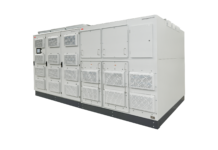
Manual bypass operations are central to the ongoing maintenance and repair of any uninterruptible power supply (UPS) system. But as with any internal bypass operation, voltage sags and spikes need to be managed carefully to avoid damage to expensive equipment and costly disturbances to business productivity.
Here, Riello UPS’ technical services manager, Jason Yates, explains how certain procedures should be performed to ensure that the UPS has greater control of the bypassing actions, providing a higher level of protection for the connected load during the transition.
How does a Riello UPS operate when switching to an internal or external maintenance bypass?
A: All Riello UPS from 10kVA upwards are supplied with an internal maintenance bypass switch, in addition to a specific pair of bypass input signal contacts, which can be used to electrically interlock the UPS to the external bypass switch.
When an operator alters a Riello UPS to internal bypass, the switch they are operating is fitted with an additional auxiliary contact (typically closed), which when operated immediately notifies the UPS’s control system. In turn, this action activates the UPS’s internal static bypass and shuts down the inverter. By doing this, the UPS effectively controls the transition to prevent any potential damage to the system.
In reverse, when the operator opens the maintenance bypass switch, the signal from the auxiliary contact notifies the UPS’s control system of this action. The system then carefully controls the transition from the static bypass to the inverter, by first restarting the inverter and synchronising it to the bypass supply. Then the inverter output voltage is raised or lowered to match the bypass supply voltage.
Finally, when safe to do so, the UPS will automatically transfer the load from the static bypass supply onto the inverter output. This changeover typically occurs at the zero-crossing point of the waveform to minimise any possible disruption to the load. Once the load has been securely transferred back onto the inverter output, the inverter will then return the output voltage level as specifically configured within the UPS.
If the system is installed with an external maintenance bypass switch, it is very important to ensure that it is fitted with an auxiliary contact (one set per UPS). This contact can be used to notify the UPS when the switch is closed so that the UPS can take the appropriate action, effectively interlocking it.
When changing to external bypass, it is important that the UPS is turned to internal bypass first. Then when returning the external bypass to the normal state (open), it is advisable to open the external bypass switch first before opening the UPS’s internal bypass.
The auxiliary contacts provided within the internal or external bypass system are specifically designed to provide protection to the UPS and the connected load during manual bypass operations.
Although these interlocks provide the required protection, it is imperative that any switching actions performed on or around a UPS follow a rigorous process and are performed by trained and authorised personnel. This recommendation is far more important when switching multiple parallel UPS devices as this is where the operation can become more complicated.
UPS Basics: Power problems
In this UPS Basics video, Riello UPS explores the most common power problems encountered in the UK, with business development manager, Steve Wood: https://youtu.be/UreKJrBJqrI



